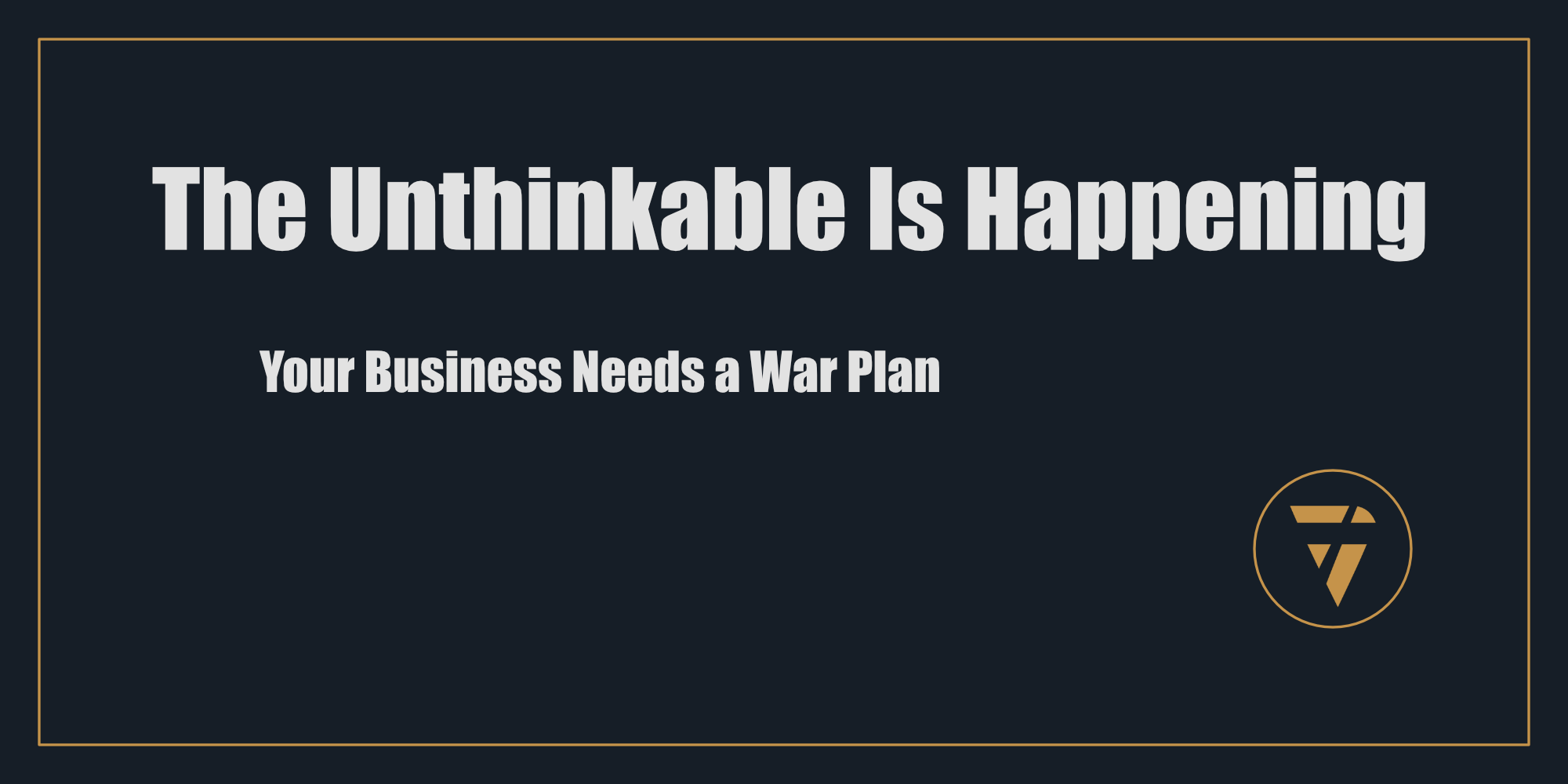The Unthinkable Is Happening

Your Business Needs a War Plan
Most business owners are optimists. It’s the nature of entrepreneurship, to take risks, to build, to bet on the future. But optimism without preparation is delusion, and in 2025, delusion is the fastest way to bankruptcy.
Look around. Global war is no longer a distant concept. It’s happening. Economic collapse is no longer a possibility. It’s unfolding. Social stability is fraying, markets are volatile, and the structures businesses have relied on for decades—supply chains, financial systems, consumer demand—are breaking down.
- Canada’s small businesses are struggling as inflation, debt, and consumer anxiety choke cash flow.
- The global supply chain is in crisis, and the once-reliable flow of goods from China, the U.S., and Europe is being disrupted by political tensions and economic warfare.
- A digital battleground is emerging, where cyberattacks, financial surveillance, and AI-driven fraud are escalating at an unprecedented rate.
- Interest rates, government intervention, and debt loads are crushing small and medium-sized businesses, while banks and investors tighten their grip on capital.
Here’s the harsh truth: If you don’t have a war plan, your business is already losing.
The Mindset Shift: Stop Waiting for "Things to Get Better"
Most business owners—especially those who have only operated in stable economies—are making one critical mistake: They believe this is temporary.
They tell themselves:
❌ "We just need to ride this out."
❌ "Things will stabilize soon."
❌ "The government will step in and help."
This is wishful thinking at best, and catastrophic denial at worst. The businesses that survive and thrive in crisis are the ones that accept reality early and move fast. The ones who wait? They become statistics.
It’s time to shift your thinking.
- Assume things will get worse before they get better. Plan for prolonged economic stress, global instability, and prolonged downturns.
- Abandon reliance on systems that worked in peacetime. The way you’ve run your business for the last 10 years may no longer be viable.
- Prioritize control, liquidity, and adaptability. Those who can pivot, preserve cash, and control their supply chains will dominate the next decade.
This is not business as usual. You are not planning for a quarter of slow sales; you are preparing to defend and fortify your business in a world that is shifting underneath your feet.
The Essential Components of a Business War Plan
A Business War Plan is not just a defensive strategy—it’s a survival system. It consists of three core pillars:
1. Scenario Planning: War-Gaming Your Business Future
Most businesses plan for best-case and moderate-case scenarios. Almost none plan for the worst. That’s why most businesses die in crisis.
How to execute scenario planning:
- Identify three crisis scenarios:
- A moderate crisis (20% revenue drop, supply chain delays).
- A severe crisis (50% revenue drop, major supply disruptions).
- A catastrophic scenario (80%+ revenue loss, government restrictions, total market collapse).
- Create an action plan for each. If X happens, we do Y. No emotion, no panic—just execution.
- Re-assess monthly. Conditions change fast; what worked three months ago may be obsolete.
Real-world application:
A retailer who ignored scenario planning saw 80% of their revenue vanish when supply chains collapsed. Those who anticipated disruption pre-stocked critical inventory, secured alternate suppliers, and pivoted to local sourcing.
2. Redundancy: What You Rely on Will Fail—Plan for It
The most fragile businesses are those that rely on a single point of failure.
- One major supplier? If they collapse, you’re out of business.
- One big client? If they go bankrupt, your revenue vanishes.
- One bank? If they freeze your funds, how do you operate?
How to build redundancy:
✅ Diversify suppliers—establish multiple backup options, even if they cost more.
✅ Spread out financial risk—use multiple banks, payment processors, and funding sources.
✅ Decentralize operations—ensure remote work and multiple logistics options.
Case study:
A Canadian manufacturing business survived 2023’s supply chain crisis because they had three alternate suppliers lined up before their main provider collapsed. Their competitors? Gone.
3. Mobility: The Power of a Nimble, Adaptable Business
A business that can move—physically, digitally, or strategically—is a business that can survive.
What mobility looks like:
- Revenue mobility: Multiple income streams (subscriptions, digital sales, services).
- Client mobility: Selling beyond local markets—global, digital, or multi-regional expansion.
- Operational mobility: The ability to relocate, pivot, or restructure quickly.
In a crisis, speed beats size. The massive corporations take months to shift. The small, adaptable business can pivot overnight and steal the market.
How to Create a Real-Time Crisis Response System
A war plan is useless without real-time execution. Here’s how to implement yours:
1. Create a "Red Alert" Business Response Team
- Identify key decision-makers who will lead in a crisis.
- Define clear escalation procedures for financial, operational, and market crises.
- Meet weekly (not monthly) for crisis updates and rapid response drills.
2. Implement a 90-Day Survival Framework
- Cash Flow Priority: Shift to a 90-day rolling financial model. Forecast every week and adjust rapidly.
- Debt & Credit Strategy: Renegotiate debt before you need to. Secure capital lines now before banks tighten access.
- Expense Control: Cut non-essentials aggressively. What you spend today affects if you survive six months from now.
3. Build a "Crisis Playbook"
Every industry has unique threats. Identify your specific risks and pre-write response plans for each:
- Cyberattack response protocol (data security, customer communication).
- Supply chain collapse plan (alternate sources, emergency stockpiling).
- Government restriction response (compliance, pivots, customer retention).
4. Set Up "War Chest" Financing
- Pre-negotiate credit lines. The worst time to seek funding is when you’re desperate.
- Secure alternate payment methods (crypto, trade credit, barter agreements).
- Move cash reserves into diversified, accessible accounts.
The Winners and the Dead
The next five years will destroy businesses that were built for stability—but they will create massive opportunities for those prepared for crisis.
🚨 Which side will you be on?
- The businesses that win will be the ones that planned.
- The businesses that survive will be the ones that adapted.
- The businesses that disappear will be the ones that waited.
There is no neutral ground. Make your move—because the war has already started.
This is what I’m working on. Tell me what you think, I enjoy the conversation! Subscribe and follow the work in real time.
Thanks!
B

Your business is not ready for what’s coming.
Most will wait. Most will hope. Most will die.
Crisis isn’t coming—it’s here. Cash flow is bleeding. Supply chains are cracking. Clients are disappearing.
You need a War Plan. Scenario planning, redundancy, mobility. Now.
The unprepared will vanish. The adaptable will dominate.
Move.
PS -






